Accounting: Revenue Recognition, Long-Term Contracts, Elkhart Case
VerifiedAdded on 2023/05/29
|7
|1340
|124
Homework Assignment
AI Summary
This accounting assignment covers key concepts related to revenue recognition and long-term contracts. It addresses the timing of revenue recognition, discussing when it's appropriate to recognize revenue at the point of sale versus over time, particularly in the context of long-term construction projects. The assignment also explores the percentage-of-completion method, its theoretical justification, and how to account for projected losses in construction contracts. Furthermore, it delves into variable consideration, illustrating its impact on transaction prices using the Elkhart case. Finally, the solution includes practical applications, such as allocating transaction prices in bundled offerings and preparing journal entries for revenue recognition, with a detailed example of a construction project spanning multiple years and its impact on financial statements.
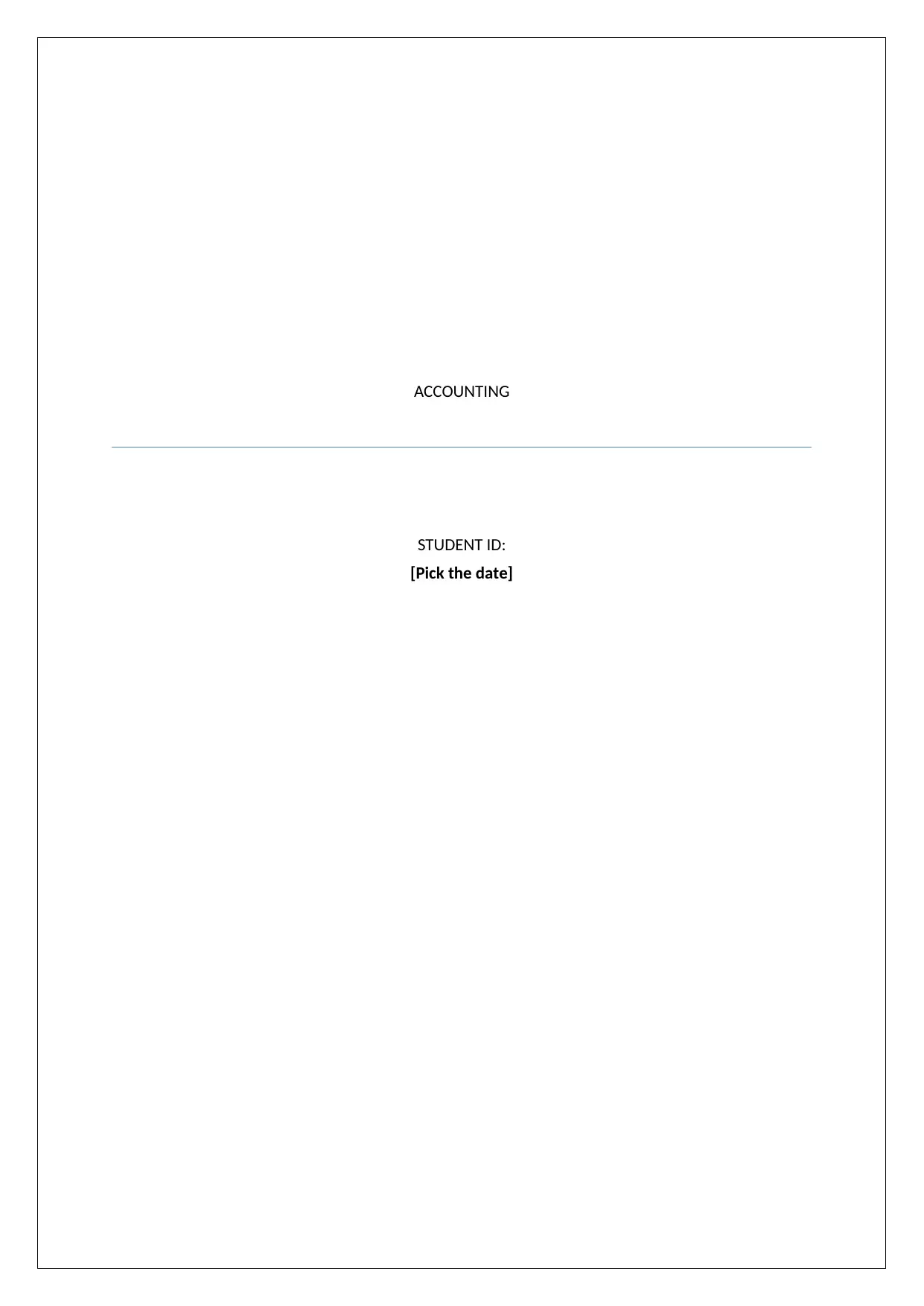
ACCOUNTING
STUDENT ID:
[Pick the date]
STUDENT ID:
[Pick the date]
Paraphrase This Document
Need a fresh take? Get an instant paraphrase of this document with our AI Paraphraser
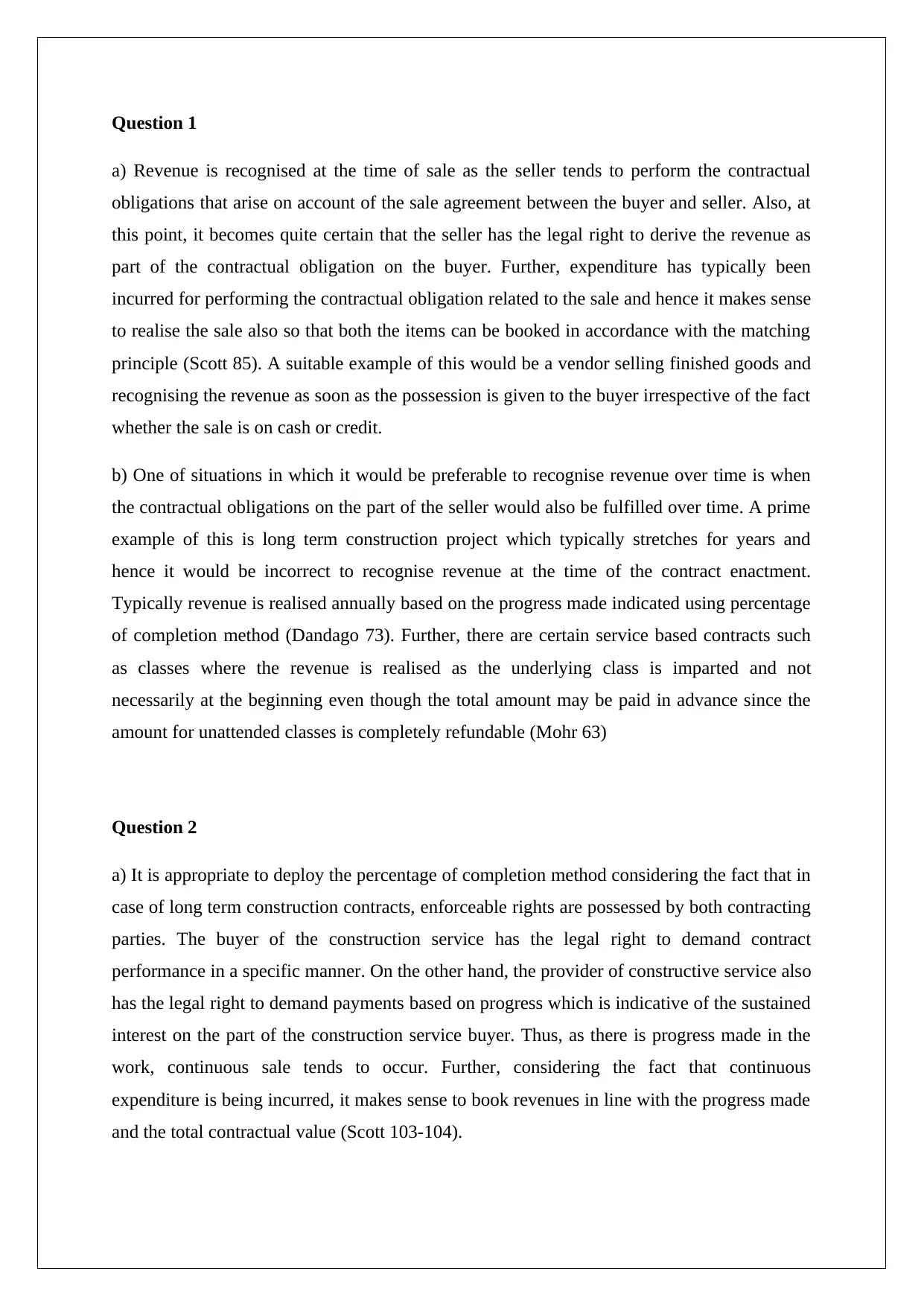
Question 1
a) Revenue is recognised at the time of sale as the seller tends to perform the contractual
obligations that arise on account of the sale agreement between the buyer and seller. Also, at
this point, it becomes quite certain that the seller has the legal right to derive the revenue as
part of the contractual obligation on the buyer. Further, expenditure has typically been
incurred for performing the contractual obligation related to the sale and hence it makes sense
to realise the sale also so that both the items can be booked in accordance with the matching
principle (Scott 85). A suitable example of this would be a vendor selling finished goods and
recognising the revenue as soon as the possession is given to the buyer irrespective of the fact
whether the sale is on cash or credit.
b) One of situations in which it would be preferable to recognise revenue over time is when
the contractual obligations on the part of the seller would also be fulfilled over time. A prime
example of this is long term construction project which typically stretches for years and
hence it would be incorrect to recognise revenue at the time of the contract enactment.
Typically revenue is realised annually based on the progress made indicated using percentage
of completion method (Dandago 73). Further, there are certain service based contracts such
as classes where the revenue is realised as the underlying class is imparted and not
necessarily at the beginning even though the total amount may be paid in advance since the
amount for unattended classes is completely refundable (Mohr 63)
Question 2
a) It is appropriate to deploy the percentage of completion method considering the fact that in
case of long term construction contracts, enforceable rights are possessed by both contracting
parties. The buyer of the construction service has the legal right to demand contract
performance in a specific manner. On the other hand, the provider of constructive service also
has the legal right to demand payments based on progress which is indicative of the sustained
interest on the part of the construction service buyer. Thus, as there is progress made in the
work, continuous sale tends to occur. Further, considering the fact that continuous
expenditure is being incurred, it makes sense to book revenues in line with the progress made
and the total contractual value (Scott 103-104).
a) Revenue is recognised at the time of sale as the seller tends to perform the contractual
obligations that arise on account of the sale agreement between the buyer and seller. Also, at
this point, it becomes quite certain that the seller has the legal right to derive the revenue as
part of the contractual obligation on the buyer. Further, expenditure has typically been
incurred for performing the contractual obligation related to the sale and hence it makes sense
to realise the sale also so that both the items can be booked in accordance with the matching
principle (Scott 85). A suitable example of this would be a vendor selling finished goods and
recognising the revenue as soon as the possession is given to the buyer irrespective of the fact
whether the sale is on cash or credit.
b) One of situations in which it would be preferable to recognise revenue over time is when
the contractual obligations on the part of the seller would also be fulfilled over time. A prime
example of this is long term construction project which typically stretches for years and
hence it would be incorrect to recognise revenue at the time of the contract enactment.
Typically revenue is realised annually based on the progress made indicated using percentage
of completion method (Dandago 73). Further, there are certain service based contracts such
as classes where the revenue is realised as the underlying class is imparted and not
necessarily at the beginning even though the total amount may be paid in advance since the
amount for unattended classes is completely refundable (Mohr 63)
Question 2
a) It is appropriate to deploy the percentage of completion method considering the fact that in
case of long term construction contracts, enforceable rights are possessed by both contracting
parties. The buyer of the construction service has the legal right to demand contract
performance in a specific manner. On the other hand, the provider of constructive service also
has the legal right to demand payments based on progress which is indicative of the sustained
interest on the part of the construction service buyer. Thus, as there is progress made in the
work, continuous sale tends to occur. Further, considering the fact that continuous
expenditure is being incurred, it makes sense to book revenues in line with the progress made
and the total contractual value (Scott 103-104).
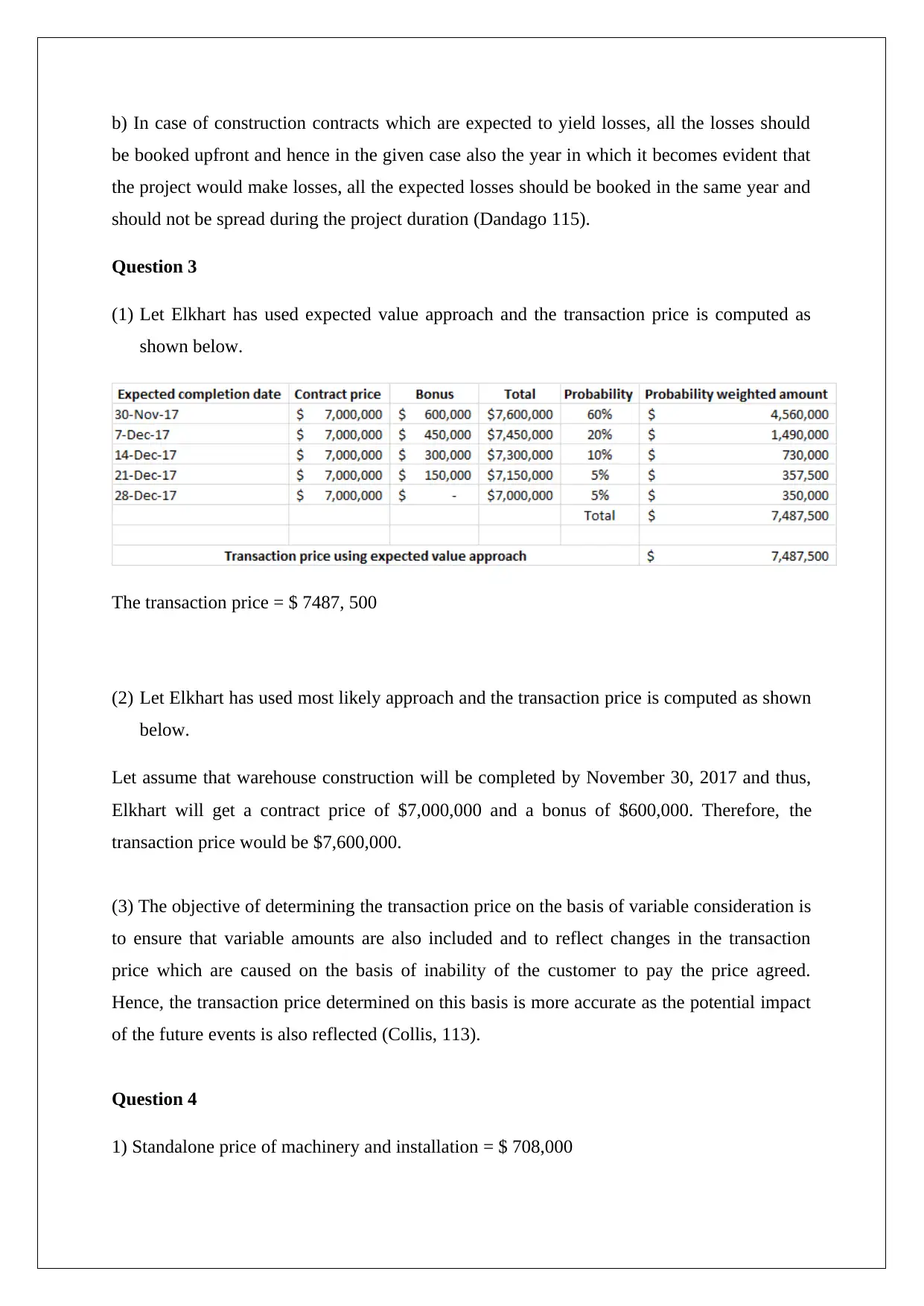
b) In case of construction contracts which are expected to yield losses, all the losses should
be booked upfront and hence in the given case also the year in which it becomes evident that
the project would make losses, all the expected losses should be booked in the same year and
should not be spread during the project duration (Dandago 115).
Question 3
(1) Let Elkhart has used expected value approach and the transaction price is computed as
shown below.
The transaction price = $ 7487, 500
(2) Let Elkhart has used most likely approach and the transaction price is computed as shown
below.
Let assume that warehouse construction will be completed by November 30, 2017 and thus,
Elkhart will get a contract price of $7,000,000 and a bonus of $600,000. Therefore, the
transaction price would be $7,600,000.
(3) The objective of determining the transaction price on the basis of variable consideration is
to ensure that variable amounts are also included and to reflect changes in the transaction
price which are caused on the basis of inability of the customer to pay the price agreed.
Hence, the transaction price determined on this basis is more accurate as the potential impact
of the future events is also reflected (Collis, 113).
Question 4
1) Standalone price of machinery and installation = $ 708,000
be booked upfront and hence in the given case also the year in which it becomes evident that
the project would make losses, all the expected losses should be booked in the same year and
should not be spread during the project duration (Dandago 115).
Question 3
(1) Let Elkhart has used expected value approach and the transaction price is computed as
shown below.
The transaction price = $ 7487, 500
(2) Let Elkhart has used most likely approach and the transaction price is computed as shown
below.
Let assume that warehouse construction will be completed by November 30, 2017 and thus,
Elkhart will get a contract price of $7,000,000 and a bonus of $600,000. Therefore, the
transaction price would be $7,600,000.
(3) The objective of determining the transaction price on the basis of variable consideration is
to ensure that variable amounts are also included and to reflect changes in the transaction
price which are caused on the basis of inability of the customer to pay the price agreed.
Hence, the transaction price determined on this basis is more accurate as the potential impact
of the future events is also reflected (Collis, 113).
Question 4
1) Standalone price of machinery and installation = $ 708,000
⊘ This is a preview!⊘
Do you want full access?
Subscribe today to unlock all pages.

Trusted by 1+ million students worldwide
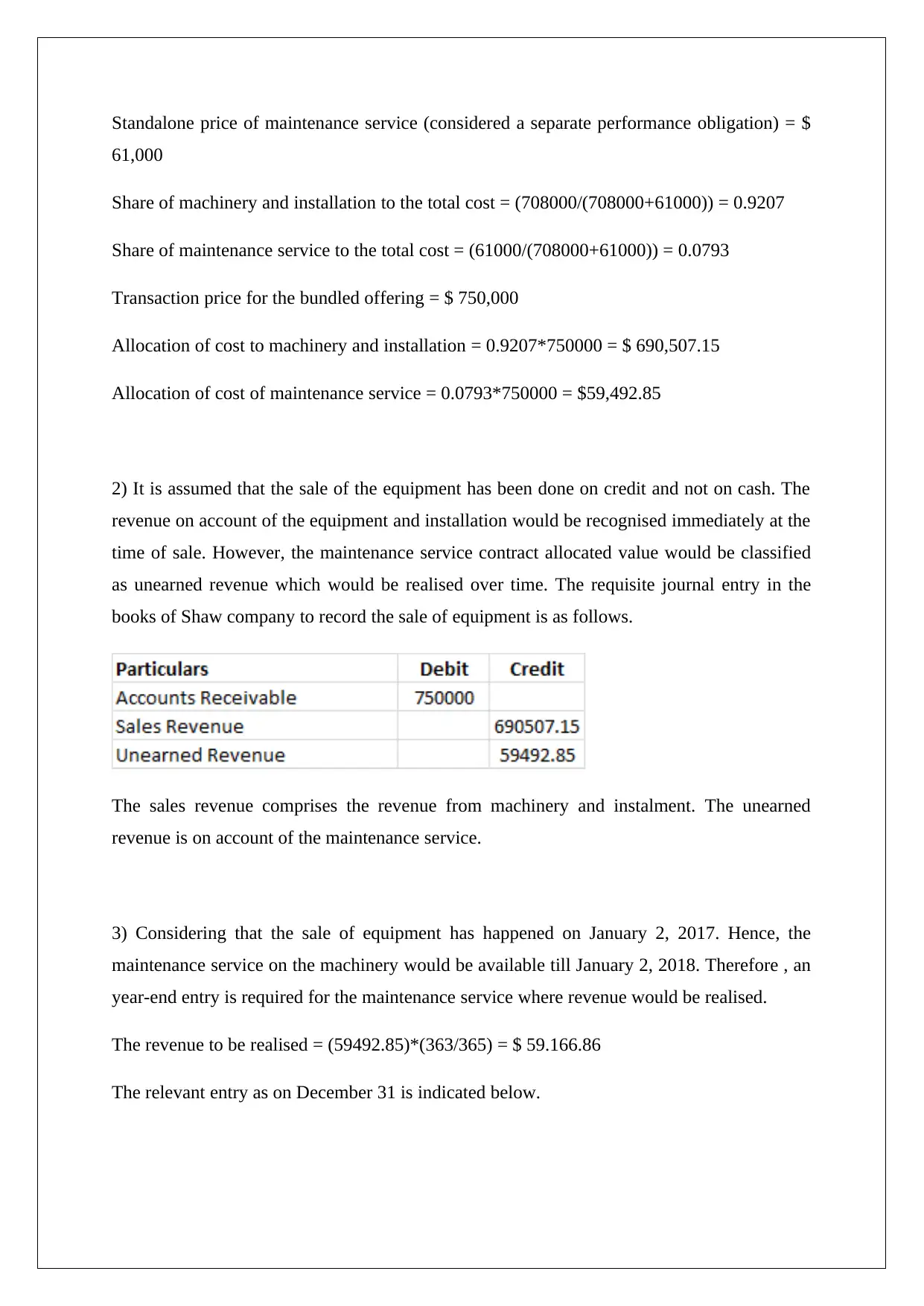
Standalone price of maintenance service (considered a separate performance obligation) = $
61,000
Share of machinery and installation to the total cost = (708000/(708000+61000)) = 0.9207
Share of maintenance service to the total cost = (61000/(708000+61000)) = 0.0793
Transaction price for the bundled offering = $ 750,000
Allocation of cost to machinery and installation = 0.9207*750000 = $ 690,507.15
Allocation of cost of maintenance service = 0.0793*750000 = $59,492.85
2) It is assumed that the sale of the equipment has been done on credit and not on cash. The
revenue on account of the equipment and installation would be recognised immediately at the
time of sale. However, the maintenance service contract allocated value would be classified
as unearned revenue which would be realised over time. The requisite journal entry in the
books of Shaw company to record the sale of equipment is as follows.
The sales revenue comprises the revenue from machinery and instalment. The unearned
revenue is on account of the maintenance service.
3) Considering that the sale of equipment has happened on January 2, 2017. Hence, the
maintenance service on the machinery would be available till January 2, 2018. Therefore , an
year-end entry is required for the maintenance service where revenue would be realised.
The revenue to be realised = (59492.85)*(363/365) = $ 59.166.86
The relevant entry as on December 31 is indicated below.
61,000
Share of machinery and installation to the total cost = (708000/(708000+61000)) = 0.9207
Share of maintenance service to the total cost = (61000/(708000+61000)) = 0.0793
Transaction price for the bundled offering = $ 750,000
Allocation of cost to machinery and installation = 0.9207*750000 = $ 690,507.15
Allocation of cost of maintenance service = 0.0793*750000 = $59,492.85
2) It is assumed that the sale of the equipment has been done on credit and not on cash. The
revenue on account of the equipment and installation would be recognised immediately at the
time of sale. However, the maintenance service contract allocated value would be classified
as unearned revenue which would be realised over time. The requisite journal entry in the
books of Shaw company to record the sale of equipment is as follows.
The sales revenue comprises the revenue from machinery and instalment. The unearned
revenue is on account of the maintenance service.
3) Considering that the sale of equipment has happened on January 2, 2017. Hence, the
maintenance service on the machinery would be available till January 2, 2018. Therefore , an
year-end entry is required for the maintenance service where revenue would be realised.
The revenue to be realised = (59492.85)*(363/365) = $ 59.166.86
The relevant entry as on December 31 is indicated below.
Paraphrase This Document
Need a fresh take? Get an instant paraphrase of this document with our AI Paraphraser
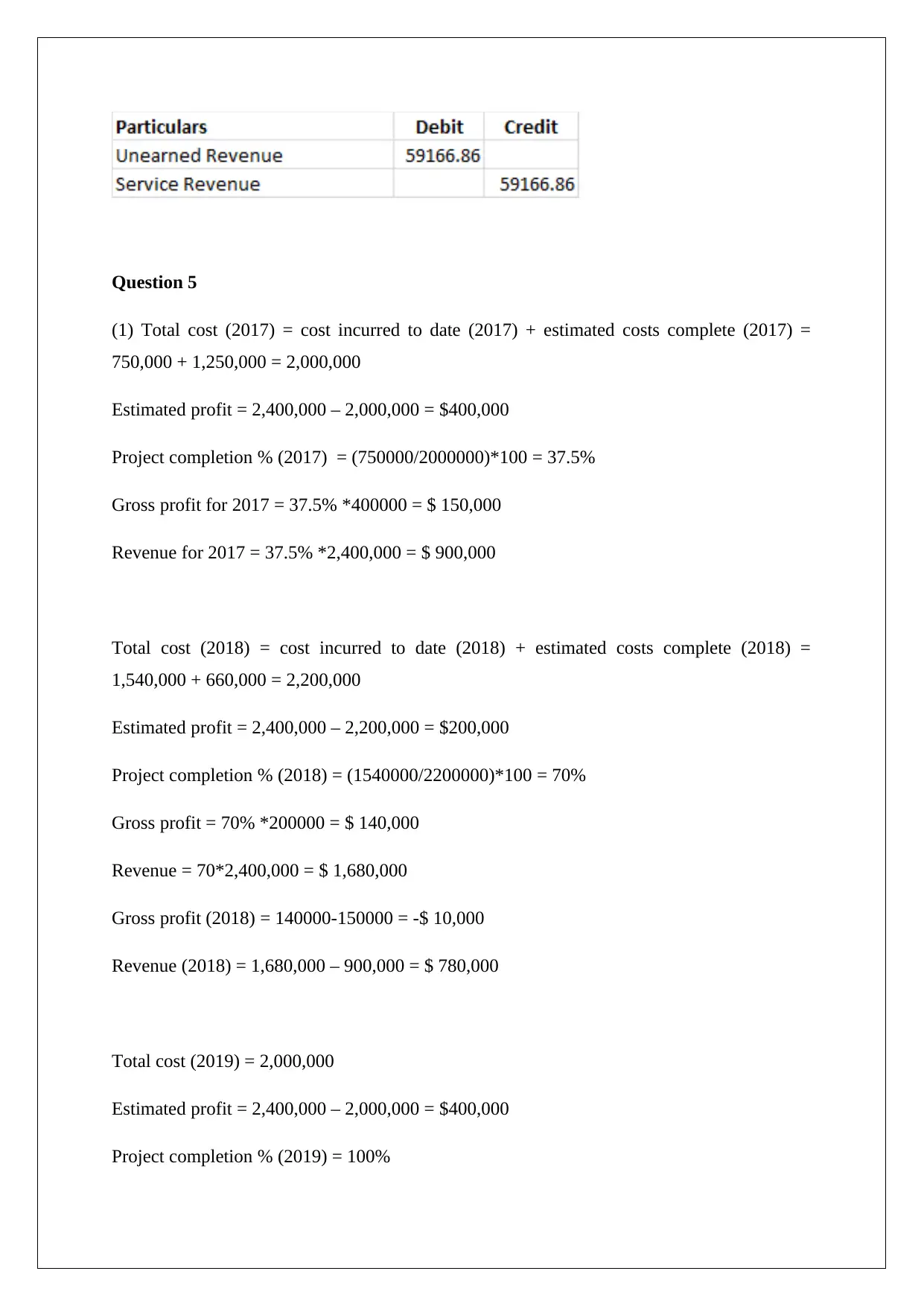
Question 5
(1) Total cost (2017) = cost incurred to date (2017) + estimated costs complete (2017) =
750,000 + 1,250,000 = 2,000,000
Estimated profit = 2,400,000 – 2,000,000 = $400,000
Project completion % (2017) = (750000/2000000)*100 = 37.5%
Gross profit for 2017 = 37.5% *400000 = $ 150,000
Revenue for 2017 = 37.5% *2,400,000 = $ 900,000
Total cost (2018) = cost incurred to date (2018) + estimated costs complete (2018) =
1,540,000 + 660,000 = 2,200,000
Estimated profit = 2,400,000 – 2,200,000 = $200,000
Project completion % (2018) = (1540000/2200000)*100 = 70%
Gross profit = 70% *200000 = $ 140,000
Revenue = 70*2,400,000 = $ 1,680,000
Gross profit (2018) = 140000-150000 = -$ 10,000
Revenue (2018) = 1,680,000 – 900,000 = $ 780,000
Total cost (2019) = 2,000,000
Estimated profit = 2,400,000 – 2,000,000 = $400,000
Project completion % (2019) = 100%
(1) Total cost (2017) = cost incurred to date (2017) + estimated costs complete (2017) =
750,000 + 1,250,000 = 2,000,000
Estimated profit = 2,400,000 – 2,000,000 = $400,000
Project completion % (2017) = (750000/2000000)*100 = 37.5%
Gross profit for 2017 = 37.5% *400000 = $ 150,000
Revenue for 2017 = 37.5% *2,400,000 = $ 900,000
Total cost (2018) = cost incurred to date (2018) + estimated costs complete (2018) =
1,540,000 + 660,000 = 2,200,000
Estimated profit = 2,400,000 – 2,200,000 = $200,000
Project completion % (2018) = (1540000/2200000)*100 = 70%
Gross profit = 70% *200000 = $ 140,000
Revenue = 70*2,400,000 = $ 1,680,000
Gross profit (2018) = 140000-150000 = -$ 10,000
Revenue (2018) = 1,680,000 – 900,000 = $ 780,000
Total cost (2019) = 2,000,000
Estimated profit = 2,400,000 – 2,000,000 = $400,000
Project completion % (2019) = 100%
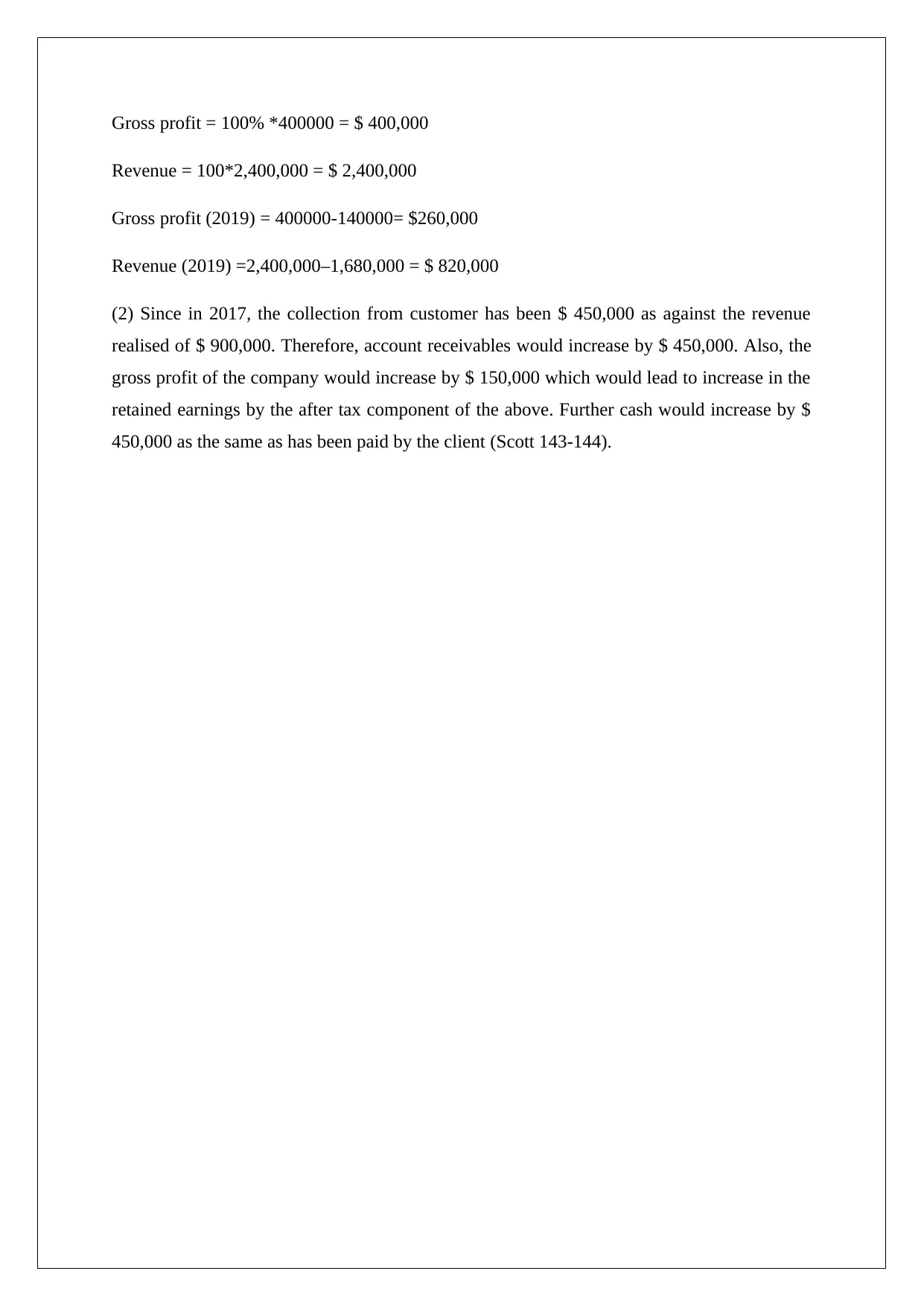
Gross profit = 100% *400000 = $ 400,000
Revenue = 100*2,400,000 = $ 2,400,000
Gross profit (2019) = 400000-140000= $260,000
Revenue (2019) =2,400,000–1,680,000 = $ 820,000
(2) Since in 2017, the collection from customer has been $ 450,000 as against the revenue
realised of $ 900,000. Therefore, account receivables would increase by $ 450,000. Also, the
gross profit of the company would increase by $ 150,000 which would lead to increase in the
retained earnings by the after tax component of the above. Further cash would increase by $
450,000 as the same as has been paid by the client (Scott 143-144).
Revenue = 100*2,400,000 = $ 2,400,000
Gross profit (2019) = 400000-140000= $260,000
Revenue (2019) =2,400,000–1,680,000 = $ 820,000
(2) Since in 2017, the collection from customer has been $ 450,000 as against the revenue
realised of $ 900,000. Therefore, account receivables would increase by $ 450,000. Also, the
gross profit of the company would increase by $ 150,000 which would lead to increase in the
retained earnings by the after tax component of the above. Further cash would increase by $
450,000 as the same as has been paid by the client (Scott 143-144).
⊘ This is a preview!⊘
Do you want full access?
Subscribe today to unlock all pages.

Trusted by 1+ million students worldwide
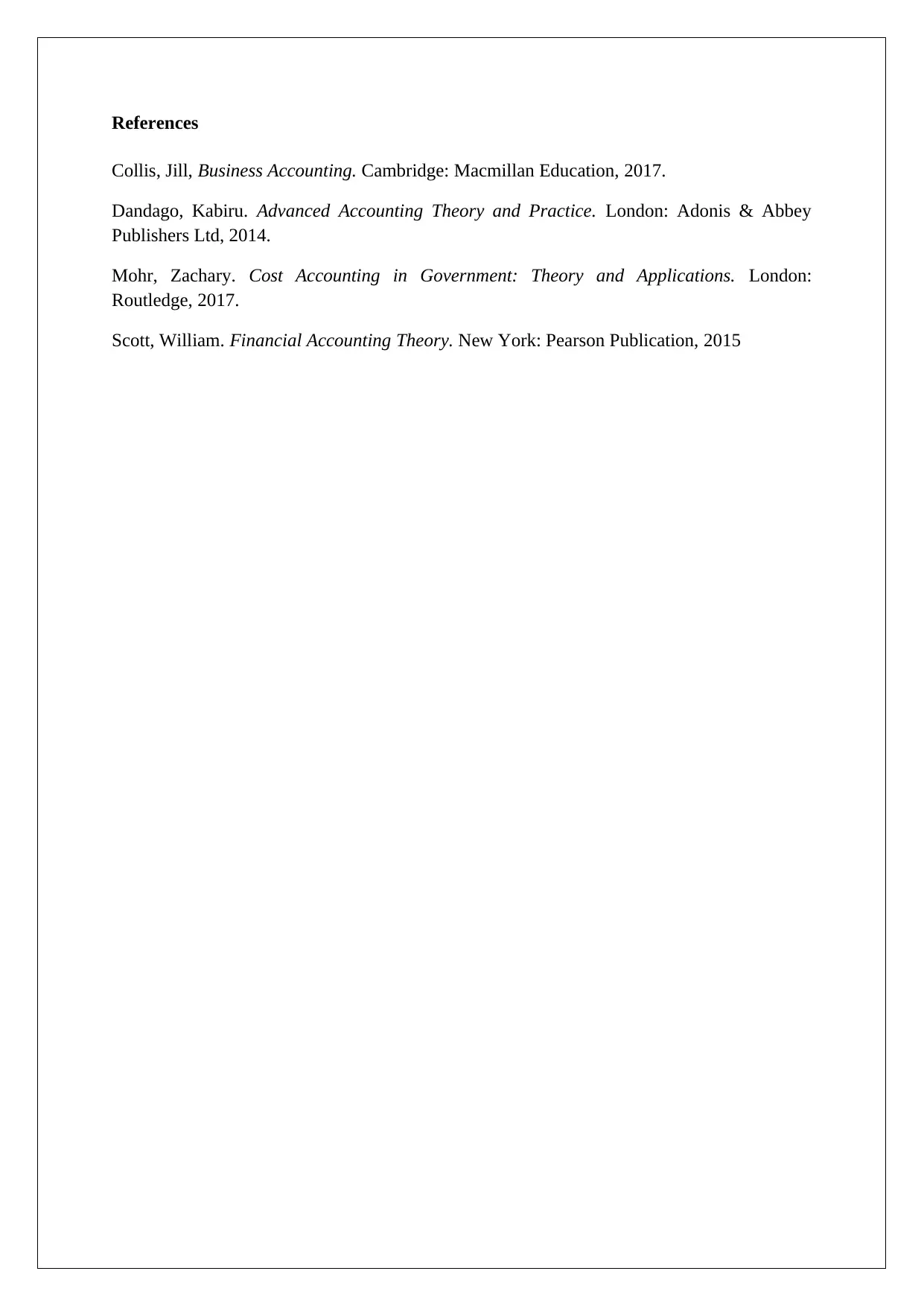
References
Collis, Jill, Business Accounting. Cambridge: Macmillan Education, 2017.
Dandago, Kabiru. Advanced Accounting Theory and Practice. London: Adonis & Abbey
Publishers Ltd, 2014.
Mohr, Zachary. Cost Accounting in Government: Theory and Applications. London:
Routledge, 2017.
Scott, William. Financial Accounting Theory. New York: Pearson Publication, 2015
Collis, Jill, Business Accounting. Cambridge: Macmillan Education, 2017.
Dandago, Kabiru. Advanced Accounting Theory and Practice. London: Adonis & Abbey
Publishers Ltd, 2014.
Mohr, Zachary. Cost Accounting in Government: Theory and Applications. London:
Routledge, 2017.
Scott, William. Financial Accounting Theory. New York: Pearson Publication, 2015
1 out of 7
Your All-in-One AI-Powered Toolkit for Academic Success.
+13062052269
info@desklib.com
Available 24*7 on WhatsApp / Email
![[object Object]](/_next/static/media/star-bottom.7253800d.svg)
Unlock your academic potential
Copyright © 2020–2025 A2Z Services. All Rights Reserved. Developed and managed by ZUCOL.